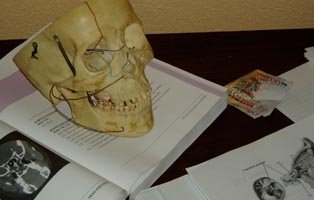Anatomy

So congratulations! If there's any course that signifies medical school to the undergrad, it's Human Anatomy. After this you should know every bone in the body, every muscle that moves them, and every nerve that orders them around. And I'm kidding. You will cover a fair bit of it, know some interesting clinical presentations, and be able to explain to your friends back home what "fight or flight" is all about. And isn't that the goal? To sound impressive?
This course has changed a bit since I took it. Instead of having every student slave away in the lab cleaning fat for a grade, the department now pro-sects (a professional dissection) every structure of interest and then takes you through ID, relationships to neighboring structures, and pop quiz. I think you get to dissect the first day on a space that's impossible to screw up too bad: the superficial back. Of course this didn't stop me from cutting all the way to the ribs on that day. And yes, an announcement was made to the class that I was an idiot.
If you've taken the course already and want to freshen up or are taking it for the first time and want a heads up, this site is great. It shows the dissection of the entire human body in easy-to-download quicktime movies. Another great website is the University of Michigan site. Several classes have lived and died by their practice quizzes. Get a wrong answer: it tells you why you're wrong. Most students click all the wrong answers anyway just to see what they might be missing. And for those of you with the free time to dream of overachieving, they have surgical videos as well.
Now for the books. The school gives you the combined oil paintings of Frank H. Netter, may he rest in peace, and the "Baby Moore" Clinical Anatomy book (make sure you read the Blue Boxes). For a book with a more gross approach to anatomy, the Color Atlas of Anatomy by Rohen is pretty clutch. Some students go so far as to buy Clemente's but between you and me: that's overkill. For those out there who like coloring books, they have those too.
The school produces their own Anatomy manual in binder format and all of the lectures are online as PowerPoints. Review at your leisure.
Strategy for covering all of this material? Who knows. The first week or two of classes is light, giving you every opportunity to study like an idiot and learn everything incorrectly. It happens, don't sweat it. Instead, learn about the different ways to study and make a trip to the Department of Educational Services (DES) office and have a chat with them. I did both; both helped. Another thing you'll probably due is attend too many DES sessions (tutored by students that are 4 months ahead of you), artificially boosting the confidence of said tutors until you cut back and find your rhythm. Best advice I received was 1) draw everything and 2) study with people smarter than you.
It's going to be the first hard class of medical school, you will get through it, and look at it this way: by the final you will be able to write out all 208 bones of the human body on a table napkin and not bat an eyelash, and that's what medical school is all about.



0 Comments:
Post a Comment
<< Home